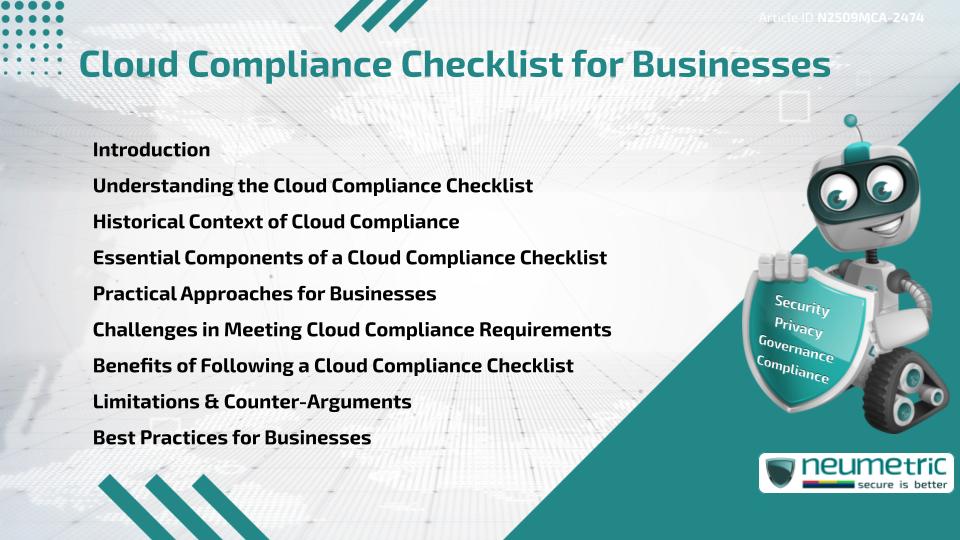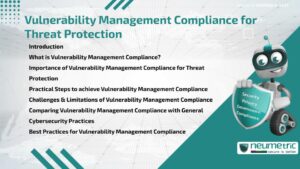Table of Contents
ToggleIntroduction
A Cloud Compliance Checklist is a structured tool that helps businesses verify whether their Cloud operations meet Regulatory requirements, Industry Standards & internal Policies. It ensures that Sensitive Data stored or processed in the Cloud is secure, while reducing Risks of legal penalties or reputational harm.
This article explores the concept, history, challenges, benefits & Best Practices of a Cloud Compliance Checklist. It provides a practical Framework for businesses seeking Accountability, Efficiency & Trust in their Cloud operations.
Understanding the Cloud Compliance Checklist
At its core, a Cloud Compliance Checklist is a guide that aligns Security, Privacy & Governance practices with external regulations such as GDPR, HIPAA or PCI DSS. It helps businesses verify whether they have implemented the necessary safeguards & processes to achieve Compliance.
Think of it as a pilot’s pre-flight Checklist. Pilots follow a list of checks to ensure aircraft safety. Similarly, a Cloud Compliance Checklist ensures that businesses do not overlook critical elements of Data Security & Governance.
Historical Context of Cloud Compliance
Cloud computing gained traction in the early 2000s, but businesses were initially hesitant due to concerns over Data Security. As adoption grew, regulators introduced rules to protect Consumer Data, forcing organisations to address Compliance in Cloud environments.
Over the years, international standards such as ISO/IEC 27017 & NIST frameworks further formalised Compliance Requirements. Today, a Cloud Compliance Checklist is essential for businesses across industries, ensuring that Cloud operations remain trustworthy & transparent.
Essential Components of a Cloud Compliance Checklist
A comprehensive Cloud Compliance Checklist should include:
- Data Security Controls: Encryption, Firewalls & Access restrictions.
- Identity & Access Management: Strong Authentication & Role-based Access.
- Regulatory Alignment: Specific controls for GDPR, HIPAA, PCI DSS or other frameworks.
- Monitoring & Auditing: Continuous Monitoring, Logging & Reporting.
- Incident Response Planning: Clear Procedures for addressing breaches or disruptions.
- Data Retention & Disposal: Policies on how long data is stored & how it is securely destroyed.
- Vendor Management: Assessing Third Party providers for Compliance guarantees.
Practical Approaches for Businesses
Businesses can apply the Checklist effectively by:
- Customising it to their industry & regulatory environment.
- Automating Compliance checks with Cloud-native tools.
- Training Employees on their role in maintaining Compliance.
- Conducting regular Audits & Assessments.
- Collaborating with Cloud providers to share Compliance responsibilities.
Challenges in Meeting Cloud Compliance Requirements
Implementing a Cloud Compliance Checklist comes with challenges such as:
- Complex Regulations: Businesses operating globally must navigate overlapping laws.
- Resource Constraints: Smaller organisations may lack dedicated Compliance staff.
- Evolving Threats: Security Risks change faster than Compliance frameworks.
- Provider Transparency: Limited visibility into Cloud Vendor practices can hinder Compliance.
Benefits of Following a Cloud Compliance Checklist
When businesses adopt a Cloud Compliance Checklist, the benefits include:
- Risk Reduction: Lower Likelihood of Breaches & Financial Losses.
- Regulatory Assurance: Protection against legal fines & disputes.
- Customer Confidence: Demonstrating Compliance strengthens Trust.
- Operational Consistency: Standardised processes reduce errors & inefficiencies.
Limitations & Counter-Arguments
Some argue that relying too heavily on a Checklist can create a “box-ticking” mentality, where businesses focus only on passing Audits rather than addressing real Risks. Others note that Compliance frameworks lag behind emerging Threats, leaving Gaps even if the Checklist is fully completed.
These counterpoints highlight the importance of using a Cloud Compliance Checklist as a foundation while also investing in proactive Security Measures.
Best Practices for Businesses
To get the most out of a Cloud Compliance Checklist, businesses should:
- Update the Checklist regularly as regulations evolve.
- Incorporate feedback from Audits & Incident Reviews.
- Align Compliance with broader Risk Management strategies.
- Foster a culture of Accountability across teams.
- Use automation to reduce human error & improve efficiency.
Takeaways
- A Cloud Compliance Checklist ensures alignment with regulations & standards.
- Key components include Data Security, Access Management & Incident Response.
- Businesses face challenges such as complex laws & provider transparency.
- Compliance improves Trust, reduces Risks & enhances Efficiency.
- Best Practices transform Checklists into strategic Compliance tools.
FAQ
What is a Cloud Compliance Checklist?
It is a structured guide that helps businesses verify Compliance of their Cloud operations with Regulations & Best Practices.
Why do businesses need a Cloud Compliance Checklist?
It reduces Risks, ensures Regulatory alignment & strengthens Customer Trust.
What should be included in a Cloud Compliance Checklist?
Key elements include Data Security, Identity & Access Management, Monitoring, Vendor oversight & Incident Response planning.
What challenges exist in using a Checklist?
Challenges include overlapping regulations, resource constraints, evolving Threats & provider transparency issues.
Does completing a Checklist guarantee full security?
No, it ensures Compliance but businesses must also adopt proactive Security Measures.
Can Small Businesses benefit from a Cloud Compliance Checklist?
Yes, it helps them streamline Compliance efforts & avoid Legal Risks, even with limited resources.
How often should a Checklist be updated?
It should be updated regularly, especially when regulations, Business Operations or Cloud environments change.
Need help for Security, Privacy, Governance & VAPT?
Neumetric provides organisations the necessary help to achieve their Cybersecurity, Compliance, Governance, Privacy, Certifications & Pentesting needs.
Organisations & Businesses, specifically those which provide SaaS & AI Solutions in the Fintech, BFSI & other regulated sectors, usually need a Cybersecurity Partner for meeting & maintaining the ongoing Security & Privacy needs & requirements of their Enterprise Clients & Privacy conscious Customers.
SOC 2, ISO 27001, ISO 42001, NIST, HIPAA, HECVAT, EU GDPR are some of the Frameworks that are served by Fusion – a SaaS, multimodular, multitenant, centralised, automated, Cybersecurity & Compliance Management system.
Neumetric also provides Expert Services for technical security which covers VAPT for Web Applications, APIs, iOS & Android Mobile Apps, Security Testing for AWS & other Cloud Environments & Cloud Infrastructure & other similar scopes.
Reach out to us by Email or filling out the Contact Form…





